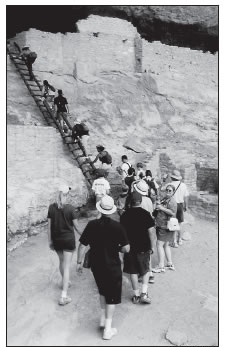A stagnant national economy has hurt local tourism in some ways, but tight vacation budgets are inspiring residents to visit attractions in their own backyards more, boosting sales and making up for losses.
In Arches National Park, Utah locals are jamming the parking lots, says park ranger supervisor Sharon Brussell.

Visitors enjoy a tour of Long House at Mesa Verde. Photo by Wendy Mimiaga
“We’ve had overflow to the point that many go on to Canyonlands National Park down the road,” she said. “With the poor economic conditions, it stands to reason that people who may have been planning a big trip far away are instead staying around, exploring their area.”
Brussell attributes Arches’ 4 percent increase in visitation, and Canyonlands’ 6 percent increase from this time last year, to people vacationing closer to home. “They’re looking to save a buck,” she added.
As of July, Arches had seen 626,757 recreation visitors for the year, up from 604,448 from the same time last year. Canyonlands National Park went from 233,967 total recreation visitors by July last year to 269,327 by the same month in 2011.
Other parks are being hit harder by the sluggish economy, but have come up with creative solutions to attract visitors.
Mesa Verde National Park has seen a 17 percent decrease for 2011 to date. As of July of this year, the park drew 274,507 visitors, compared to 329,913 by the same time last year. The month of July totals were especially low, dropping 26 percent from last year.
To help offset the fickle tourism, park managers began offering several backcountry hiking tours to ruins not usually open to the public, and the response has been huge.
“We’re selling out of tickets for these tours. People really have a great experience,” said Laurel Rematore, executive director of the Mesa Verde Association.
Special care is taken by park archeologists to protect the thousand-year-old structures in remote areas of the ruins-rich park, but managers also understand the importance of sharing this cultural heritage with the public.
“It’s great for locals who have already visited the park’s main features, like Balcony House and Cliff Palace, a few times and want a different experience, so it gets people back to the park who might not have otherwise returned,” Rematore said.
New tours are on a trial basis to monitor any potential impacts, but so far there have been no problems. Now visitors can sign up to explore (with a guide) remarkable ruins such as Spring House, Square Tower House and Oak Tree House and Fire Temple. Go to www.mesaverdeinstitute.org for tour availability and more information.
In general, Cortez has had a steady tourism industry, reports Mesa Verde Country director Lynn Dyer, in part because the area does not suffer from boom-and-bust cycles, so the highs and lows are never too extreme.
“Some lodgers and businesses are up one month, while others are down, and then the next month it is the other way around, so overall it has been OK, considering the economy,” she said.
July visitation at the Colorado Welcome Center in Cortez was higher than expected, Dyer said, and Mancos and Dolores also saw good numbers this summer, though those have dipped recently.
“I think people are driving more for vacation because that is still the cheapest way to travel, and it is cheaper to explore your own backyard, too, so we see a lot of regional travelers,” she said.
“But I’ve seen license plates from Washington, Oregon, Canada, Florida and Maine as well. Motorcyclists are very fond of this area’s excellent roads and are coming through in droves yearround.”
A few hours away in Arizona at Grand Canyon National Park, attendance is holding at approximately 2.6 million year-to-date, nearly exactly the same as last year, reports Shannan Marcak, public-affairs specialist.
“We fluctuate just like everyone else does, but because the Grand Canyon is a destination park, away from urban areas, people tend to be more resistant to changing their plans once they have decided to come here.”
In tough times, visiting national parks is a good bargain, she said.
“Parks are nice because they offer opportunities for traveling for different budgets, so if you were planning to stay at hotels but can’t afford that now, you can still make the trip and stay at a park campground.”

